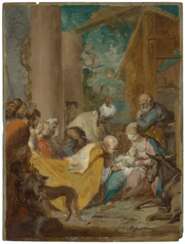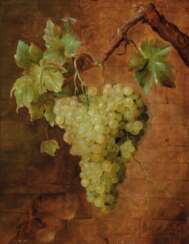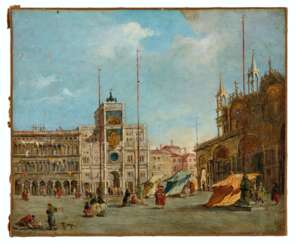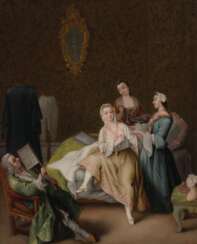рококо картины





Francesco Fontebasso was an Italian painter of the late-Baroque or Rococo period of Venice. He first apprenticed with Sebastiano Ricci, but was strongly influenced by his contemporary, Giovanni Battista Tiepolo.


Nicolas Vleughels was a French painter. In his role as director of the French Academy in Rome, which he held from 1724 until his death, he played a pivotal figure in the interchange between French and Italian art and artists in the first third of the 18th century.


François Lemoyne, a French Rococo painter born in 1688, was renowned for his mastery in history painting and his significant contributions to art during the early 18th century. As a notable figure in the French art scene, Lemoyne aspired to be recognized as the successor to Charles Le Brun and aimed to position himself as the leading painter of his era. His works, particularly those at Versailles, garnered him the admiration of his contemporaries, earning him the epithet "the new Le Brun".
François Lemoyne's artistic journey was marked by his studies in Rome, where he drew inspiration from the works of Old Masters like Raphael, Correggio, and Titian. However, Peter Paul Rubens, with his distinctive use of color, had a profound influence on Lemoyne's style. Throughout his career, Lemoyne's art evolved, showing a stronger Italian influence, notably in his admiration for Paolo Veronese's work.
One of François Lemoyne's significant achievements was winning a royal commission in 1728 to paint the ceiling of the Salon d’Hercule at Versailles, a task he completed with great acclaim from figures like Voltaire and Cardinal Fleury. His appointment as Premier peintre du Roi in 1736 marked the pinnacle of his career. Tragically, in 1737, at the peak of his artistic prowess, Lemoyne committed suicide, a decision attributed to a combination of personal and professional pressures.
For collectors and experts in art and antiques, François Lemoyne's work offers a deep dive into the Rococo era's elegance and grandeur, reflecting the sophisticated tastes of early 18th-century French society. His legacy lives on through his contributions to iconic French landmarks and the mentorship he provided to future artistic talents like François Boucher.
If you're fascinated by the opulent world of Rococo art and wish to delve deeper into the life and masterpieces of François Lemoyne, consider subscribing to our newsletter. You'll receive curated updates on exhibitions, newly discovered works, and exclusive insights into Lemoyne's influence on 18th-century art. Join our community of art enthusiasts and enhance your appreciation of this remarkable artist and his era.

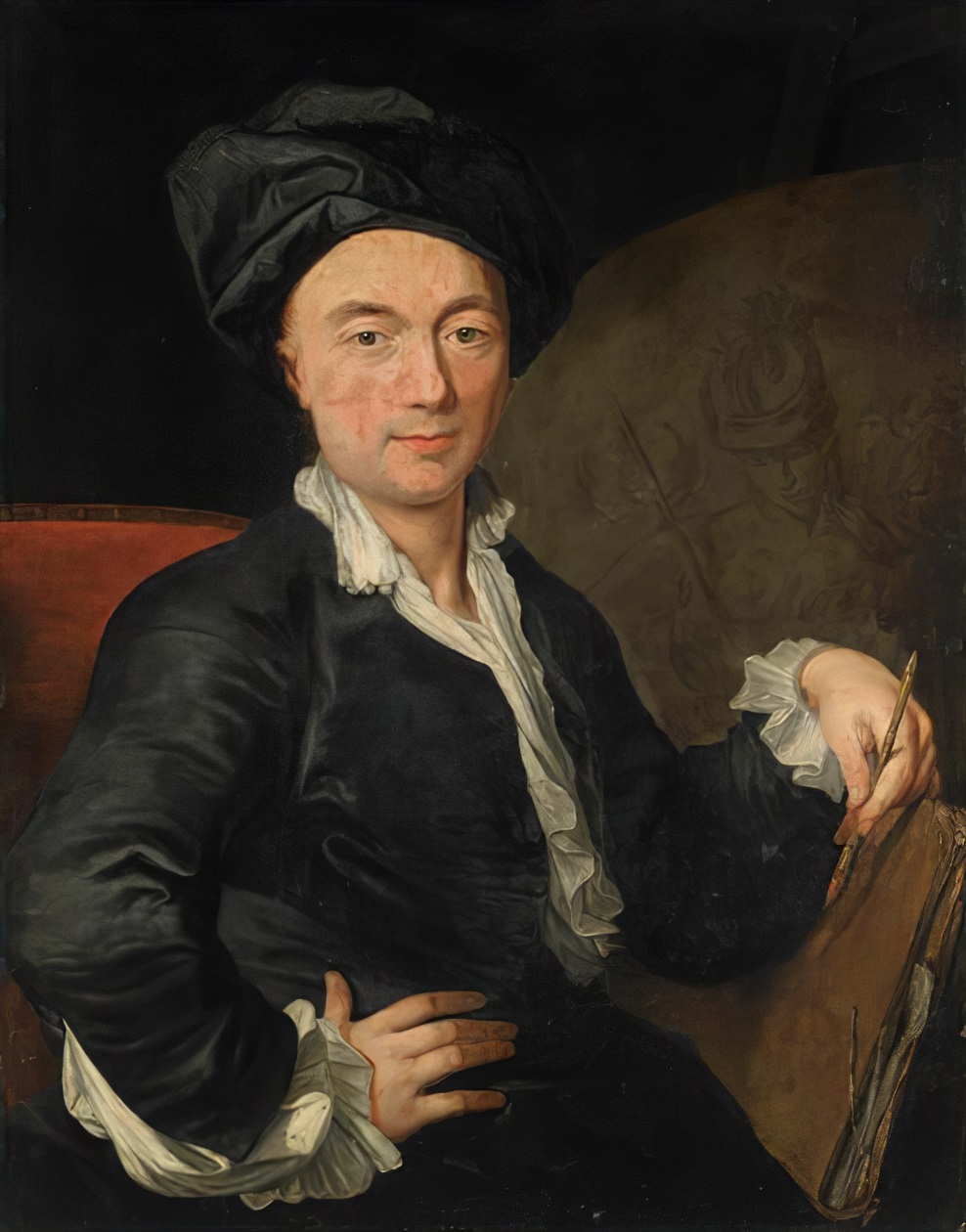
Jean-Baptiste Pater was a French rococo painter.


Thomas Hudson was an English portrait painter.
Hudson was most prolific between 1740 and 1760 and, from 1745 until 1755 was the most successful London portraitist.
Many of Hudson's works may be seen in art galleries throughout the United Kingdom. They include the National Portrait Gallery, the National Maritime Museum, Tate, Barnstaple Guildhall, Foundling Museum and the Bristol City Museum and Art Gallery.


Jean-Baptiste Marie Huet was a French painter, engraver and designer associated with pastoral and genre scenes of animals in the Rococo manner, influenced by François Boucher.


Canaletto, born Giovanni Antonio Canal, was an illustrious Italian painter celebrated for his masterful cityscapes, particularly of Venice and London. Emerging as a topographical painter after 1719, Canaletto became renowned for his detailed and atmospheric views, known as vedute, which captured the essence of Venice and London with a unique blend of accuracy and artistic embellishment. Despite using a camera obscura to achieve precision in his architectural details, Canaletto often infused his paintings with creative adjustments to enhance their appeal.
His early works, such as "The Stonemason's Yard," are particularly prized for their vivid portrayal of Venice's daily life and architectural beauty. Canaletto's paintings were highly sought after by English aristocrats during their Grand Tours, leading him to spend a significant period in England, where he continued to produce esteemed works capturing the English landscape and urban scenes.
Despite his international success, Canaletto's work was less appreciated in his native Venice during his lifetime, only gaining broader recognition and appreciation in later years. His legacy, however, has had a lasting impact on landscape painting, influencing future generations of artists.
If you're interested in staying updated on art exhibitions and auctions featuring Canaletto's work, consider signing up for newsletters from art galleries or auction houses that specialize in historical artworks. This way, you'll be informed about new sales and exhibition events related to Canaletto without any exaggerated language or promises.


Francesco Lazzaro Guardi was an Italian painter, nobleman, and a member of the Venetian School. He is considered to be among the last practitioners, along with his brothers, of the classic Venetian school of painting.
In the early part of his career he collaborated with his older brother Gian Antonio in the production of religious paintings. After Gian Antonio's death in 1760, Francesco concentrated on vedute. The earliest of these show the influence of Canaletto, but he gradually adopted a looser style characterized by spirited brush-strokes and freely imagined architecture.


Nicolas Lancret was a French painter. Born in Paris, he was a brilliant depicter of light comedy which reflected the tastes and manners of French society during the regency of the Duke of Orleans and, later, early reign of King Louis XV.


Jean-Antoine Watteau was a French painter and draughtsman whose brief career spurred the revival of interest in colour and movement, as seen in the tradition of Correggio and Rubens. He revitalized the waning Baroque style, shifting it to the less severe, more naturalistic, less formally classical, Rococo. Watteau is credited with inventing the genre of fêtes galantes, scenes of bucolic and idyllic charm, suffused with a theatrical air. Some of his best known subjects were drawn from the world of Italian comedy and ballet.


Pietro Longhi was a Venetian painter renowned for his intimate depictions of daily life in 18th-century Venice. His works, void of biting satire but possibly tinged with gentle irony, provide a unique window into the social and domestic spheres of Venetian society. Pietro Longhi's art captures a range of everyday moments, from high society gatherings to common street scenes, all characterized by a keen observation of human interaction and behavior.
Pietro Longhi's training began under the tutelage of the history painter Antonio Balestra and continued with Guiseppe Maria Crespi in Bologna, whose influence is evident in Longhi's detailed genre scenes. Returning to Venice, he shifted his focus to these smaller, more personal vignettes, starting in 1741. His works, such as "The Charlatan" and "The Ridotto in Venice," highlight the public and private lives of Venetians, often showcasing masked figures engaging in various activities, hinting at the city's famous carnival culture.
Notable works like "The Exhibition of a Rhinoceros at Venice" reflect Pietro Longhi's interest in capturing contemporary events and curiosities, offering insight into the leisure and entertainment of the time. This particular painting is part of the National Gallery's collection and stands out for its depiction of public fascination with exotic animals, intertwined with social commentary.
For collectors and art experts, Pietro Longhi's paintings are invaluable for their historical context and artistic merit, capturing the essence of Venetian life with a unique blend of realism and subtlety. His works continue to be celebrated for their detailed narrative quality and their ability to transport viewers to the heart of 18th-century Venice.
For those keen on exploring more about Pietro Longhi's contributions to art and culture, and to stay updated on sales and auction events featuring his works, subscribing for updates can be a valuable way to stay informed.


Jean Siméon Chardin was an 18th-century French painter. He is considered a master of still life, and is also noted for his genre paintings which depict kitchen maids, children, and domestic activities. Carefully balanced composition, soft diffusion of light, and granular impasto characterize his work.


Francesco Lazzaro Guardi was an Italian painter, nobleman, and a member of the Venetian School. He is considered to be among the last practitioners, along with his brothers, of the classic Venetian school of painting.
In the early part of his career he collaborated with his older brother Gian Antonio in the production of religious paintings. After Gian Antonio's death in 1760, Francesco concentrated on vedute. The earliest of these show the influence of Canaletto, but he gradually adopted a looser style characterized by spirited brush-strokes and freely imagined architecture.


Nicolas Vleughels was a French painter. In his role as director of the French Academy in Rome, which he held from 1724 until his death, he played a pivotal figure in the interchange between French and Italian art and artists in the first third of the 18th century.




















